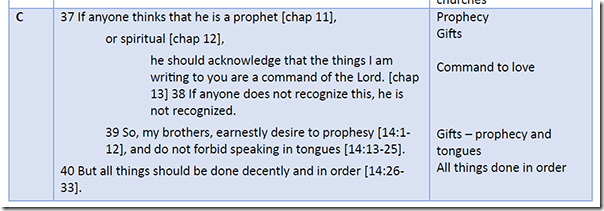It is all too easy for the loudest and most prolific voices to dominate what a young Christian hears about gender relationships in the Christian church.
My twenties were found during the 1990’s. Looking back on that era now, it seems like there was a considerable amount of effort directed toward Christian men to “reclaim” what it meant to be a godly man.
As a young husband and father, I recall going through parenting workshops and reading family and parenting books emphasizing ideas I now understand to be based on patriarchy and complementarianism to varying degrees.
On the surface, these ministries, classes, and books made quite a bit of sense to a young Christian wanting to live right and “biblically.” And I was almost taken in by them. Almost. But there were things that bothered me. They taught what appeared to be a singular vision for what a godly man, a godly woman, and a godly family looks like. The implication was that anything else was less than the biblical ideal.
For over a decade I didn’t know what to do with the discomfort I felt about what was taught to me about gender and family in the church. Then a few years ago I began to encounter blogs and books showing there are other ways to interpret and apply biblical texts, including those dealing with gender. One of those was The Junia Project.
INTERPRETATION MATTERS
These resources are important to me because they provide something I didn’t have when I was struggling and questioning – other ways of interpreting. This is why I believe it is important to spread the word. I don’t want my daughters to find themselves in places where their contributions and roles are limited and their personhood marginalized because of one particular way of reading and applying the biblical text as “biblical.”
For example, consider this text: 1 Corinthians 14:34-35 and 37.
The traditional interpretation points to these verses as “proof” that women are to remain silent in church and, by inference, that they are not to take part in leading public worship (vv.34-35, 37). But when I took a closer look I realized that there are many problems with using this passage to support the idea that women must maintain a lesser role.
THE FIRST PROBLEM
The first is that In the preceding set of verses (vv.26-33) Paul instructs both the tongues-speakers and the prophets to “remain silent” (v. 28) or “be silent” (v.30) under certain conditions. The women are instructed to “keep silent” (v.34) as a third group in the series. The problem for modern interpreters is that Paul does not appear to provide any explanation of those limiting conditions in the text itself.
THE SECOND PROBLEM
Paul gave instructions in chapter 11 to women who did prophesy and lead in public worship (11:5). The second problem then is that Paul would appear to be contradicting himself if verses 34-35 of chapter 14:34-35) are interpreted as literal and universal.
THE THIRD PROBLEM
A third problem is that, in its context, the word frequently translated as “women” (v. 34) can refer to either “women” or “wives”. The meaning must be determined from the context, so in this case it is best translated as “wives”, because the next verse refers to “their husbands”. This means that at the very least, unmarried women are not included in Paul’s instruction.
THE FINAL PROBLEM
The final problem I note here is with the “command” Paul refers to in v.37. Frequently those who wish to “prove” that Paul intended women’s silence to be binding and universal will point to this verse. On the surface it could be read as pointing back to its immediate antecedent, which is indeed the command to remain silent and ask their husbands at home.
But when the entire rhetoric of vv. 37-40 is viewed, it becomes clear that Paul is mostly likely referring to the command that love be the context for all Christian activity, found in chapter 13.

The crux for interpreting, understanding, and applying this passage comes in 14:33a: “For God is not a God of confusion but of peace.”
This appears to be a hinge verse that summarizes why the gifts of tongues and prophecy must be employed in a controlled manner, such that in some cases silence is necessary. It also introduces the reason Paul instructs wives to remain silent. The wives in the Corinthian church were disrupting worship and causing confusion, preventing other worshipers from hearing and learning.
CONFUSION IN CORINTH
Kenneth Bailey provides, in great depth, a reconstruction of what he believes was happening in the Corinthian church, based upon his experiences among the present-day peoples of the area. (See Chapter 4.7 of Paul Through Mediterranean Eyes: Cultural Studies in 1 Corinthians.) Here is his line of thought, briefly:
- The Corinthian church was perhaps the most diverse in composition – including those fluent in Greek and those with just enough to get by
- Some of those speaking during worship may have had strong accents of a non-native Greek speaker, making understanding difficult for some hearers. So they might ask those around them to explain what they were hearing
- Due to their cultural upbringing, women were handicapped with a very short attention span, as short as fifteen seconds
- When they were not being directly addressed and/or didn’t understand what was being said, they would quickly begin chatting amongst themselves
- Men and women may have sat separately. If this was the case, wives may have shouted across the divide to their husbands to ask them to explain
- Therefore, the wives are instructed to respect the others in worship and remain silent and ask questions once at home
- In a predominantly oral culture, as soon as the speaker pauses the audience begins discussing the subject amongst themselves. It is particularly prominent in women’s gatherings. It is their way of learning and retaining information.
- Paul’s instruction is not that women should stop participating, speaking, and leading worship. Paul’s instruction is that they should keep quiet so that everyone is afforded the opportunity to hear what the speaker is saying.
THE BOTTOM LINE
Nowhere in 1 Corinthians does Paul give a universal command, applicable to all places, peoples and times, that women and men have different roles in the church.[2]
Paul affirms the right of women to lead, speak, and teach the entire church during public worship.
To see it otherwise is terribly faulty and holds dire consequences for the integrity and health of the church. To maintain practices that divide the service of men and women in the church is, in effect, doing that which the Corinthians were being corrected by Paul for – condoning and encouraging divisions, creating a class of people that were considered “more spiritual” by the nature of gifts. Paul would be appalled.
What I’ve come to realize is that the message of this passage is clear and simple: When in public worship, respect one another. Show love by remaining silent when others are speaking so that those around you can listen and learn. Nothing more, nothing less.
YOUR TURN: How does knowing more about the literary and cultural context of 1 Corinthians 14 impact your understanding of this “difficult passage”?
This post is adapted from the series on 1 Corinthians on Mark’s blog – Essays to Corinth.
NOTES
[1] Reading the New Testament: Reading Corinthians, 1 Cor. 14:20-36, “Conclusion”.
[2] And I hasten to add that such instruction is not found in any of the remaining undisputed Pauline writings.
For additional arguments about why this passage should be not be used to limit women’s participation in worship see Must Women Keep Silent? 1 Corinthians 14: The Apostle Paul and the Traditions of Men by Bob Edwards and Interpretations and Applications of 1 Corinthians 14:34-35 by Margaret Mowczko.




28 responses to “On 1 Corinthians 14 & Women’s Silence in Church”
I’ve had the very great pleasure to sit at Ken Bailey’s feet (well, not literally . . . ) while he taught at the New Wilmington Mission Conference, a number of times. Since his retirement, Dr. Bailey is now local to the New Wilmington area, and he is widely revered and loved by many long-time NWMC conference-goers.
Yes, I absolutely love Ken’s diving into the text! He is definitely a structuralist. That, combined with his in-depth, exhaustive understanding of Middle East culture adds to my awe at reading most things he has written. Oh, and his beyond-thorough knowledge of many languages spoken or used in the Middle East. Not only Koine Greek, Hebrew, Aramaic, and Arabic, but also dialects and variants.
I know I’m fan-girling, but Ken is also a pastoral, genial guy. I’ve had several extended conversations with him over the years, and I consider him to be a giant among biblical expositors as well as theologians. I would strongly recommend what he wrote about 1 Corinthians as material that has great weight and worth. @chaplaineliza
Another great post! I relate very much to Mark’s personal experience, and if I am honest found some of the patriarchal teaching attractive, but for all the wrong reasons.
Whilst there is much debate to be had on the details of the exegesis of this passage, surely, if a reasonably educated person were to read the whole letter it is immediately clear that Paul is not making any blanket restrictions on the role of women within the Kingdom of God. To my mind the treatment of women it is one the greatest tragedies to beset the body of Christ, and I never fail (as a non academic) to be staggered at how many great minds swallow the deception, hook, line and sinker. Surely the debate isn’t around should women be silent or not, but instead about what did those Corinthian meetings look like, and how does that apply to us today?
Must check those books out 😀
One other nit-picky point:
It is my understanding that the separation between men and women did not come until much later, under the influence of the Islamic incursion through Egypt, Asia Minor (Turkey) and Spain.
Even the Synagogues did not separate men and women until the Islamic take-over during the Medieval era.
So to say that in 53AD, (the time of Paul’s writing of 1Cor.) there was a separation of men and women in the Corinthian church would be historically inaccurate.
If we are going to hold on to that verse, you’ve got to tell a different story.
I don’t believe retrojecting “modern” behavior is a way to explain the Corinthian church either. The world that was the sea-port, multy-cultural city of Corinth cannot explain Paul’s order for women/wives to be utterly silent. Philosophically he appears to be contradicting himself.
I also tend to side with Phil Paine (as un-palatable as that can be for some) but there is presidence: Romans 8:1 (b) which is now not even foot-noted any longer in newer Bibles (the “who walk not after the flesh but according to the Spirit” from v. 4 scribal addition) ; and the “brackets” around John 7:53-8:11–I don’t know anyone who has a problem with the understanding that story is not a part of the most authoritative manuscripts.
I still tend to think that is a scribal addition as well…even though of all the explanations Aida Besançon Spencer is the best, most reasonable explanation for the continued inclusion of those verses.
That’s my two-cents worth. 😉
The Jewish New Testament Commentary allows that the practice of separation could have been happening already during Paul’s time. So my personal view is that the argument can go either way.
I do have Gordon Fee’s commentary and understand the view that some of the text may be a gloss. I chose to take the side that keeps all the text as genuine Pauline.
Your conclusion on the ultimate purpose of the passage is golden, Mark. Nicely done.
I’m afraid of opening a can of worms here, but there is a reasonable amount of evidence that verses 34-35 are an interpolation anyway. Some of the oldest manuscripts have these two verses in a variety of placements, and if you read 33 and 36 consecutively it makes contextual sense. It’s quite possible that they were added, which will never be a popular theory I fear.
Fee and Payne argue for it being an interpolation, which is another possible way to understand it. But this involves removing text, which can be a hard sell.
The most important thing to see is that there are faithful understandings of the passage that do not limit women in church. In this particular passage, this is one of the places where I disagree with Bailey and agree with David Joel Hamilton in “Why Not Women?”.
Hamilton sees the teaching unit as being 1 Cor 14:26-40 (instead of 2 teaching units like Bailey). When seen in this larger immediate context, the whole passage forms a chiasm that is 4 layers deep (ABCDD’C’B’A’). 1 Cor 14:36 can be faithfully understood (per Bruce Fleming in “Familiar Leadership Heresies Uncovered”) to contain 2 Greek eta’s (expletives of repudiation) which negate the saying in 1 Cor 14:34-35 which is seen as being from Corinthian legalists who are getting their ideas from the so-called Oral Torah of the Pharisees (“what the Law says”), which in this case negates Scripture.
Don, I lean towards this interpretation as well. It sure would be easier if the original manuscripts included some punctuation, wouldn’t it? LOL. Thanks for mentioning Hamilton’s book – I highly recommend it as an accessible starting point for people with questions. I had not heard of Bruce Fleming’s work, so looking forward to exploring that resource – such a great title!
Don, thank you for providing another way to look at this section. However the details of this specific section are interpreted, it is important to keep in mind that in the big picture Paul didn’t prohibit women from exercising leadership gifts within the Corinthian church.
Thanks for this helpful post, and especially for the links to Bob’s and Margaret’s posts at the end. It is so important to understand the great diversity of interpretative options. I have become convinced of the “quote” interpretation, because it makes the most sense in the structure of the Greek as well as the context of the following “response” of “What?” from Paul. May the Spirit blow a cleansing wind through the hearts and minds of the church and all our brothers and sisters, bring unity and mutuality rather than division and subjugation. Be blessed….
Peggy, I’m glad you looked at Bob and Margaret’s posts as together these resources give us a very comprehensive look at all of the issues around this passage. We almost added a note about the fact that many scholars today don’t believe these verses at the end of chapter 14 were Paul quoting something someone else had said (as you mentioned) and that there are those who don’t believe these words were actually written by Paul. It’s helpful to realize either way, we can’t use them as a weapon against women’s participation. Always appreciate it when you weight in 🙂
LOL … you can find “many scholars” for every opinion out there! The important thing is for each of us is to be “Berean” and do the hard work of reading all the different opinions, listen to the counsel of those you trust, pray that the Spirit gives you wisdom and discernment, and then carry on faithfully until such time as another opportunity to address the issue presents itself. We will continue to look “through a glass darkly” until the day we see “face to face” … so we just live with as much integrity as we can with the light we have. 😉
Under Greco-Roman house laws, all members of households were supposed to follow the religion of the head of the household (usually senior male).
Given this, it is possible that Paul was trying to silence the disruption of the non-Christian wives who were there only to comply with law and custom, and didn’t understand what was going on. They would be the ones who would need to ask questions, but Paul was saying they should ask their husbands at home.
We know that there were many women who defied the household laws by becoming Christian without their husbands. They, and all the single women could not be included in the silencing, since they had no Christian husbands to ask! It wouldn’t make sense for Paul to silence SOME Christian women (the married ones) while the others were allowed to speak, since they could prophecy and speak in tongues (in order).
When someone wrests passages from the whole of the New Testament, interpreting Paul without the gospel, the other apostles and the entirety of the things Paul himself said, the result is confusion or contradiction.
Amen! Preach it, sister! Love this, Michelle. Thanks for reminding us about the other group of women who would have been excluded from “being silent”.
I did a brief google on culture and women’s attention span in ancient Rome. Couldn’t find anything. So I too would like some references on that idea. Also, the average attention span in the U.S. has gone from 12 seconds to 8 seconds since the year 2000. (http://www.statisticbrain.com/attention-span-statistics/) So, if Roman women had an average attention span of 15 seconds then they were doing better than most Americans.
Our Western-trained minds do wander, but our educational environment trains us to refocus. In re-reading Bailey’s experience that he relates, my guess is these women were nearly always in the home or with domestic duties, keeping track of a whole hosts of things that required attention from one moment to another, switching from one to another. An extended lecture or sermon would pose a significant challenge. (As it does also for many of us today.)
At times like this I wish there was a “Like” button!
Mark: Thank you for the excellent post and for including Kenneth Bailey’s analysis on this passage. His scholarly and unbiased discussion has helped me tremendously in solidifying my egalitarianism and supporting my belief that my role as a ruling elder is scriptural and fully supported by Jesus’ and Paul’s teachings and ministries.
Mary McAlister
Mary, another essential book that you might find helpful if you haven’t already discovered it, is Phil Payne’s Man and Woman: One in Christ. So glad you have found a place to use your leadership gifts!
This is a good, short post on why there are problems with interpreting the verses that are usually used to inhibit women from various offices in the Church. I am putting Kenneth Bailey’s book on my amazon wishlist to read at another time.
I am confused/curious about the following:
“Due to their cultural upbringing, women were handicapped with a very short attention span, as short as fifteen seconds”
I am not an anthropologist so this makes very little sense to me. I look forward to learning more about this!
I know Mark is traveling today so it may take him awhile to comment, but I have Bailey’s book so will try to look this up and get back to you later today. I also did a double-take when I read that!
Thanks, Gail!
Bailey relates an example from his time in the region. He writes about a time he taught a group of women and how he had to break apart his materials into 15-second segments, look one woman in the eye, address her, teach, then go to the next woman. He attributes this to the social context where women are raised in an environment where long attention spans required for teaching and learning are absent.
What’s interesting is that due to technology and the ways people are interacting with it, those of who teach the millienial generation and younger often do the same thing!